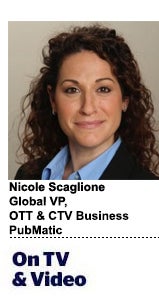“On TV & Video” is a column exploring opportunities and challenges in advanced TV and video.
Today’s column is by Nicole Scaglione, global VP of OTT at PubMatic. After this exclusive first look for subscribers, the piece will be published in full on AdExchanger.com on Monday.
In November, Omnicom issued a “call to action” to encourage industry adoption of CTV standards. Though CTV is the hot new programmatic media channel, the lack of standards is hampering market growth. Like any new digital media channel, CTV suffers from fraud, a lack of clear media-buying signals for buyers used to legacy processes and a hodgepodge of approaches to measurement.
These issues make buyers wary of stepping outside their comfort zone. Most CTV media spend has been concentrated within the networks and broadcasters that already have relationships with linear buyers. For digital native and midsize CTV publishers, adopting transparency standards can be a path through that barrier.
The good news is we don’t need to wait for standards to be handed down before we can create positive momentum with media buyers like Omnicom. There are several best practices that publishers can put in place to dramatically increase their appeal to CTV media buyers. In particular, CTV publishers can increase transparency, improve data sharing and fight fraud.
Create more transparent media buying
When it comes to programmatic CTV advertising, publishers are playing a game of cat and mouse with media buyers. On the one hand, publishers know that media buyers would be more likely to buy if they could access specific details about content. However, there are fears this could cause “cherry picking,” where media buyers only bid on specific inventory rather than a wider array of impressions.
That issue can be addressed with a pretty simple approach: raising CPM prices to compensate for changes in volume. Publishers can justify the price change with their own data. But even more compelling, raising prices is unlikely to turn off media buyers. Many CTV buyers have experience on linear TV and are used to paying premium prices for premium content placements.
For publishers ready to make the shift, it’s important to create clear and consistent standards when sharing data about impression placement and content. Using the “content object” field in the OpenRTB API is a smart move. It will ensure the information is presented within the bidstream. Standardization could start with the IAB’s content taxonomy.
Additionally, it’s important to collaborate with third-party verification partners to validate the content that’s been sold. It’s also time to transition to media buying metrics that are universally approved, such as a third-party-approved household ID. Media buyers want to plan and buy confidently, and they need to audit their buys on a regular basis to ensure they’re getting what they expect.
Make sure whatever verification is available fits the format that works best for the media buyer. Provide measurements like incremental reach, frequency, on-target demo and other CTV/TV-specific metrics.
Play ball with identity
Publishers hesitant to share first-party data are missing an opportunity to become closely embedded with premium media buyers. Publisher data is a premier component of many brand and agency identity strategies, and they will be more likely to buy media with partners that also share insights.
AdExchanger Daily
Get our editors’ roundup delivered to your inbox every weekday.
Daily Roundup
This doesn’t mean publishers need to risk giving data away. With a secure data-sharing strategy, publishers can provide media buyers with the insights they need to target their own audiences or augment their own insights. Companies like Snowflake and InfoSum have data clean room technology that facilitates secure data sharing. It can be customized to suit the publisher’s requirements.
By collaborating on a data strategy with media buyers, publishers will also get comfortable with new key identifiers. For example, Omnicom, for one, does not prefer IP addresses as key identifiers because these tend to be prone to fraud. Publishers that are willing to work with media buyers to find viable alternatives will be at the top of the media plan.
Step up anti-fraud measures
A recent report from DoubleVerify estimated CTV fraud costs publishers $144 million annually – a number that certainly will grow. In addition to outright fraud, there are also a number of technical anomalies unique to CTV. One issue that has been uncovered shows that ads can sometimes run when the TV screen is turned off.
Publishers that roll up their sleeves and work to reduce issues that are both fraudulent and technical will gain the trust of media buyers. In particular, publishers should be transparent about issues and willing to share data and insights with both media teams and third-party quality companies to solve problems. For example, if CTV publishers implemented the Open Measurement SDK, it would open up new demand because it would provide transparency and build trust with buyers.
CTV publishers have a valuable asset – quality content that commands premium prices. In order to keep the interest of media buyers, they need to play ball during this period of rapid growth, helping create standards and a transparent market that rewards good partners.
Follow PubMatic (@PubMatic) and AdExchanger (@adexchanger) on Twitter.













